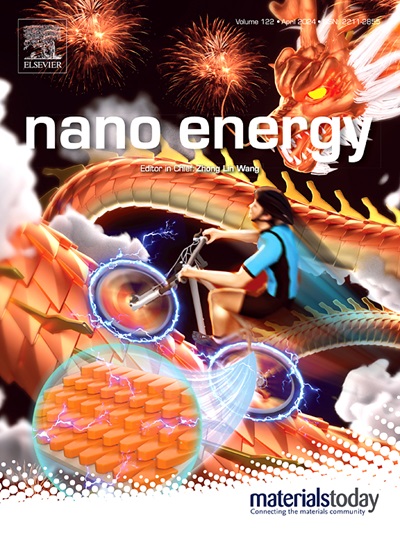Magnetically driven wireless implantable interface polarization-enhanced triboelectric nanogenerator for promoting neural cell differentiation
IF 16.8
1区 材料科学
Q1 CHEMISTRY, PHYSICAL
引用次数: 0
Abstract
The advancement of implantable electronic devices has significantly improved medical diagnostics, therapeutics, and regenerative medicine. To realize the trend of unwired, simple-operation and high-safety, electronic implantation. We developed an implantable magnetic driving TENG (IMD-TENG) with a zero-Poisson's-ratio design, which processes a novel biodegradable and biocompatible PVA-chitosan (PVA-CS) aerogel by exploiting interface polarization. The electrical performance of CS-based TENGs, achieving an open circuit voltage of 1431 V, and a short circuit current density of 3.88 μA cm-2. Leveraging the PVA-CS aerogel's excellent biocompatibility and degradability, IMD-TENG was applied in vivo energy supply and electrical stimulation. The results demonstrated the IMD-TENG's compatibility with biological tissues and stable output, along with positive effects on the growth and neurite elongation of SH-SY5Y neuron cells, promoting neuronal maturation and increased Tau protein expression. This innovative approach provides a new avenue for developing implantable bioelectronic devices, with potential applications in treating neurodegenerative diseases and advancing nerve tissue engineering.

求助全文
约1分钟内获得全文
求助全文
来源期刊

Nano Energy
CHEMISTRY, PHYSICAL-NANOSCIENCE & NANOTECHNOLOGY
CiteScore
30.30
自引率
7.40%
发文量
1207
审稿时长
23 days
期刊介绍:
Nano Energy is a multidisciplinary, rapid-publication forum of original peer-reviewed contributions on the science and engineering of nanomaterials and nanodevices used in all forms of energy harvesting, conversion, storage, utilization and policy. Through its mixture of articles, reviews, communications, research news, and information on key developments, Nano Energy provides a comprehensive coverage of this exciting and dynamic field which joins nanoscience and nanotechnology with energy science. The journal is relevant to all those who are interested in nanomaterials solutions to the energy problem.
Nano Energy publishes original experimental and theoretical research on all aspects of energy-related research which utilizes nanomaterials and nanotechnology. Manuscripts of four types are considered: review articles which inform readers of the latest research and advances in energy science; rapid communications which feature exciting research breakthroughs in the field; full-length articles which report comprehensive research developments; and news and opinions which comment on topical issues or express views on the developments in related fields.
 求助内容:
求助内容: 应助结果提醒方式:
应助结果提醒方式:


